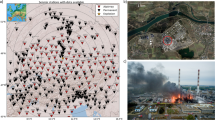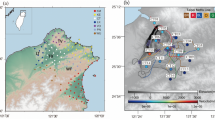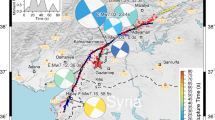Abstract
SEISMIC stations in southern California recorded the atmospheric shock waves generated by the space shuttle Columbia on its return to the Edwards Air Force base on 13 August 1989 (Fig. 1). In addition to the shock wave, the broad-band IRIS–TERRAscope station at Pasadena recorded a distinct pulse with a period of ~2–3 seconds, which arrived 12.5 seconds before the shock wave (Fig. 2). This pulse was also recorded at the University of Southern California, near downtown Los Angeles, where it arrived 3 seconds after the shock wave. The origin of this pulse could not be readily identified. We show here that it was a seismic P wave excited by the motion of high-rise buildings in downtown Los Angeles, which were hit by the shock wave. The proximity of the natural period of the high-rise buildings to that of the Los Angeles basin enabled efficient energy transfer from shock wave to seismic wave.
This is a preview of subscription content, access via your institution
Access options
Subscribe to this journal
Receive 51 print issues and online access
$199.00 per year
only $3.90 per issue
Buy this article
- Purchase on Springer Link
- Instant access to full article PDF
Prices may be subject to local taxes which are calculated during checkout
Similar content being viewed by others
References
Carlson, H. W. & Maglieri, D. J. J. acoust. Soc. Am. 51, 675–685 (1972).
Cook, J. C., Goforth, T. & Cook, R. K. J. acoust. Soc. Am. 51, 729–741 (1972).
Ben Menachem, A. & Singh, S. J. Seismic Waves and Sources 1-1-1108 (Springer, New York, 1981).
Garcia, F. J., Jones, J. H. & Henderson, H. R. NASA tech. Pap. 2475, 1–42 (National Aeronautics and Space Administration, Washington, DC, 1985).
Jennings, P. C. Bull. seismol. Soc. Am. 60, 2037–2043 (1970).
Liu, H.-L. & Heaton, T. Bull. seismol. Soc. Am. 74, 1951–1968 (1984).
Helmberger, D. V. & Vidale, J. E. Bull. seismol. Soc. Am. 78, 109–121 (1988).
Working Group on California Earthquake Probabilities, US Geological Survey Open-File Report 88–398 (US Geological Survey, US Department of the Interior, Washington, DC, 1988).
Hauksson, E. J. Geophys. Res. 95, 15365–15394 (1990).
Author information
Authors and Affiliations
Rights and permissions
About this article
Cite this article
Kanamori, H., Mori, J., Anderson, D. et al. Seismic excitation by the space shuttle Columbia. Nature 349, 781–782 (1991). https://doi.org/10.1038/349781a0
Received:
Accepted:
Issue Date:
DOI: https://doi.org/10.1038/349781a0
This article is cited by
-
The optical, seismic, and infrasound signature of the March 5 2022, bolide over Central Italy
Scientific Reports (2023)
-
Effects of site–city interaction and polarization of the incident S-wave on the transfer function and fundamental frequency of structures
Natural Hazards (2019)
-
Joint deconvolution of building and downhole seismic recordings: an application to three test cases
Bulletin of Earthquake Engineering (2018)
-
Quantification of modification of ground motion due to urbanization in a 3D basin using viscoelastic finite-difference modelling
Natural Hazards (2016)
-
Study of role of basin shape in the site–city interaction effects on the ground motion characteristics
Natural Hazards (2015)
Comments
By submitting a comment you agree to abide by our Terms and Community Guidelines. If you find something abusive or that does not comply with our terms or guidelines please flag it as inappropriate.



